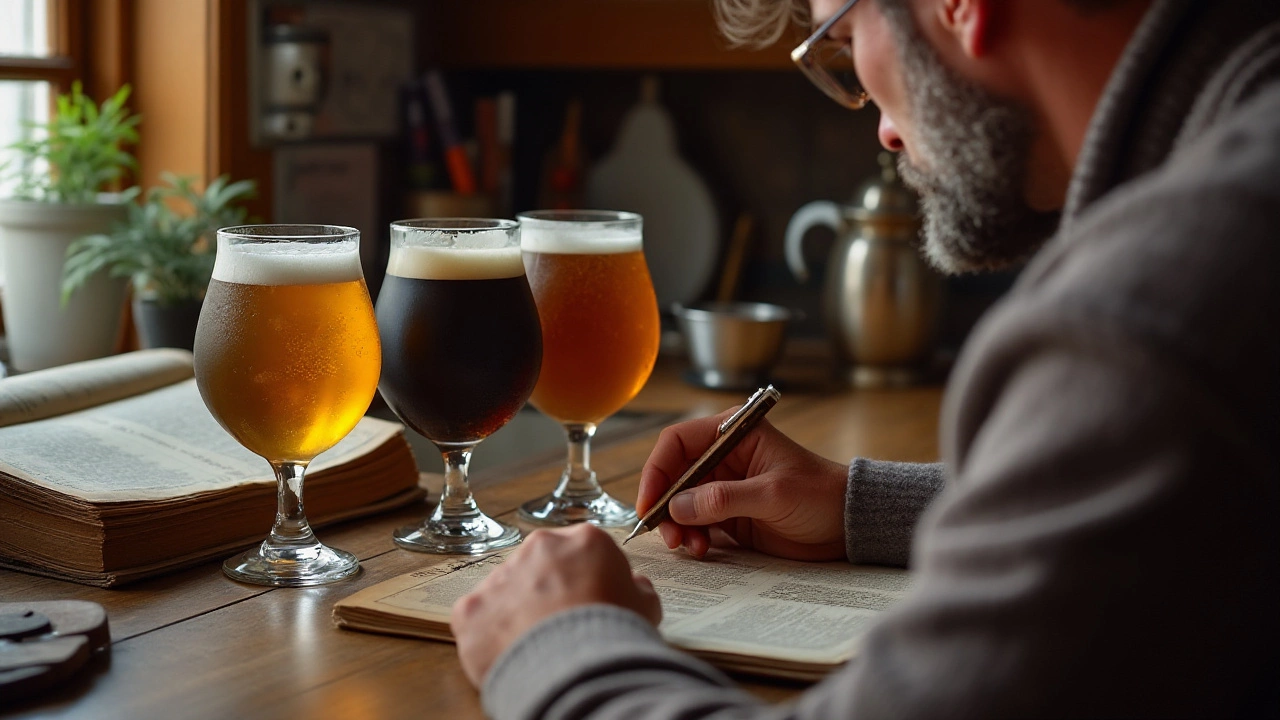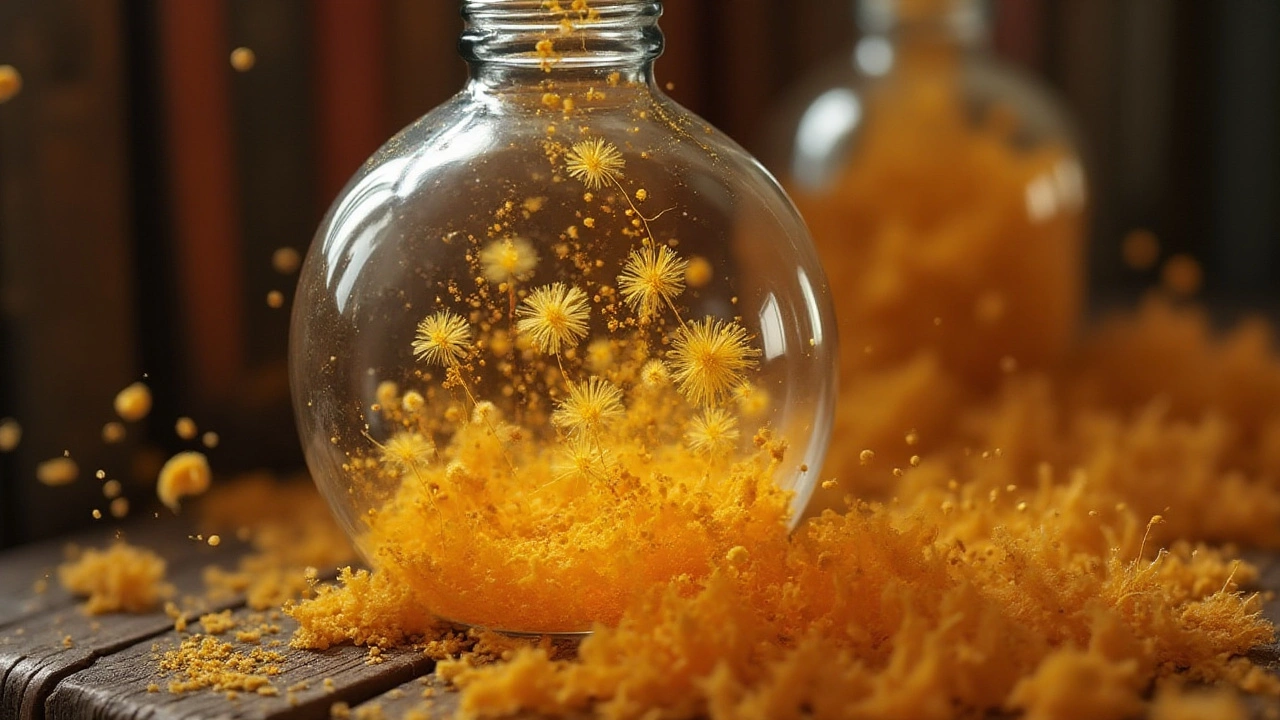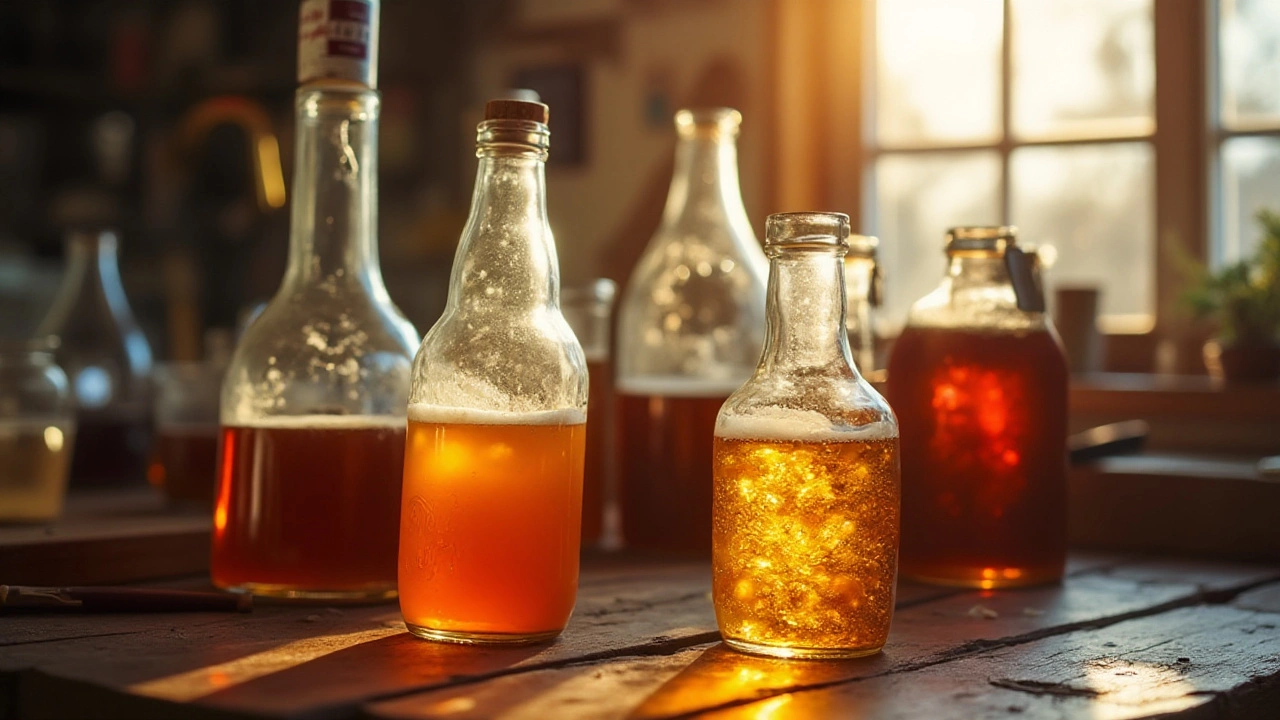For those who have ventured into the world of home brewing, the magic and mystery of fermentation are central to creating that perfect batch of beer. The process, while rooted in ancient tradition, is guided by precise science. Understanding how fermentation time can change the beer's strength and flavor is key to mastering the art of brewing.
Beer lovers and amateur brewers often ask if letting the beer ferment longer makes it more potent. It's a worthwhile question, especially when seeking to either tweak the punch of a batch or simply try something new. The truth lies in how the yeast interacts with sugars over time, converting them into alcohol and carbon dioxide.
As we explore the factors that play into a beer's final character, knowledge is power. The more informed you are about the dynamics of fermentation, the better equipped you will be to experiment and innovate. Get ready to dive deep into brewing tips and science that can elevate the quality of your homemade brews.
- The Science Behind Fermentation
- How Time Affects Beer Strength
- Yeast's Role in Alcohol Content
- Balancing Flavor and Fermentation
- Expert Tips for Homebrewers
The Science Behind Fermentation
Fermentation is a riveting process where all the magic really happens in beer fermentation. This is the stage where yeast, a humble microorganism, transforms the sugary concoction known as wort into the alcoholic delight that is beer. When we dive into the science, it’s clear that yeast is not just a passive player; it's a powerhouse that works tirelessly to turn sugars into alcohol and carbon dioxide through glycolysis. This biochemical reaction is the linchpin of the brewing process. Yeast strains, selected for their unique characteristics, are key to this transformation. Depending on the strain, they can drastically change the profile of the beer. Some strains are adept at enhancing specific flavors, while others can withstand higher alcohol concentrations, proving resilient even in more challenging conditions.
Temperature is another crucial factor influencing fermentation. Yeast works best within a specified range, typically between 15 to 24 degrees Celsius for ales. However, each yeast strain has its sweet spot, and staying within this range ensures the yeast can optimally convert sugars. This doesn't just affect the alcohol content; it can also influence the balance of flavors. Too hot, and you risk fusel alcohols which can give off hot, solvent-like flavors. Too cold, and fermentation might stall, leaving unwanted sweetness and potentially ruining a batch.
Interestingly, the chemistry behind fermentation is both art and science, and sometimes unexpected surprises do occur. For example, beers like Lambics rely on spontaneous fermentation, where wild yeast and bacteria from the environment contribute to its signature sour taste. These naturally occurring agents create a complex tapestry of flavors hard to replicate with controlled fermentation processes. An interview with a well-known brewmaster once revealed, "Every batch tells a story; it's a tapestry of microbial life working together in harmony."
When you boil down the mechanics, the length of the fermentation process is also worth noting. Usually, a primary fermentation phase lasts a few days to a week, depending on the starting gravity and desired end result. Following this, secondary fermentation can occur. This stage isn’t about increasing the strength necessarily but allows flavors to mature, sediment to settle, and the brew to develop its character. During each stage, maintaining airtight conditions is vital to avoid oxidation and contamination, both of which can spoil the batch. Some advanced home setups include fermenters with pressure-release valves or glass carboys to oversee the magic happening within.
In essence, home brewing is as much about understanding and respecting the science as it is about tasting and enjoying the final product. The beauty lies in the details, the subtle yet profound transformation that takes place from grain to glass, driven by biology and controlled by time, temperature, and technique. So the next time you crack open a bottle of your homebrew, you’re not just experiencing a drink; you’re celebrating a symphony of science at its finest.
How Time Affects Beer Strength
The duration of beer fermentation is akin to the brewing alchemist's control over the elixir's potency. As yeast feasts on sugars, time becomes the essential ingredient in determining how much alcohol your brew develops. The relationship is straight-forward: the longer the yeast works, the more sugar is converted to alcohol, thus intensifying the beer's strength.
With that said, it's important to remember that there is a sweet spot when it comes to fermentation. If beer is left to ferment for too long, it can start developing off-flavors. The yeast can start breaking down proteins and other compounds creating unwanted tastes. Hence, monitoring fermentation progress through hydrometer readings is crucial to ensure alcohol levels meet your desired outcome without compromising flavor.
"Understanding how to balance fermentation time is what separates good brews from exceptional ones," says John Palmer, noted author of 'How to Brew'. Key to this balance is temperature control during fermentation, as it influences how active the yeast will be. High temperatures can speed up fermentation, whereas cooler conditions slow it down, thus impacting the overall timeline.
Another aspect to consider is whether you're brewing an ale or a lager. Ales typically take less time to reach their peak strength due to the warmer fermentation temperatures, usually between 18 to 24°C. Lagers, on the other hand, ferment at cooler temperatures, 7 to 13°C, needing a longer period to achieve desired alcohol content.
Impact on Different Beer Styles
Not all home brewing styles are created equal, and fermentation time will vary based on the type of beer you're aiming to perfect. For instance, a strong IPA may require a bit longer fermenting to develop the ABV (Alcohol By Volume) necessary for that bold, hoppy punch. Conversely, a refreshing pale ale might come into its prime much sooner. Belgian beers often use specific strains of yeast that require extended fermentation to develop their unique complex flavors alongside higher alcohol content.
Adjusting the fermentation time also allows brewers to experiment with certain flavors. Letting a beer sit for those extra days can sometimes lead to something unexpectedly delightful. A notable tip for brewers is maintaining meticulous records of fermentation times and outcomes, so you can replicate successful batches easily or understand what might have gone wrong with others.
The Balancing Act: Fermentation Time vs. Flavor
The art of brewing is just as much about patience as it is about precision. Home brewers must constantly tweak the balance between fermentation time and flavor complexity. As a brewer, these decisions will define your personal style, taking into account both experience and acquired taste. Experimentation is encouraged, but staying informed about yeast choices and fermentation techniques will aid significantly. The knowledge that time can be a catalyst for both strength and flavor is invaluable.
| Beer Type | Ideal Fermentation Time | Typical ABV |
|---|---|---|
| Ale | 1-2 weeks | 5-6% |
| Lager | 3-4 weeks | 4-5% |
| IPA | 2-3 weeks | 6-7% |

Yeast's Role in Alcohol Content
In the mysterious world of beer fermentation, yeast stands as the unsung hero transforming sweet wort into a delicious brew. This fascinating little organism plays a pivotal role in determining the alcohol content of any beer, acting as the very engine of fermentation. When yeast is introduced to the wort, a sugary brew of grains, it gets to work consuming sugars and producing alcohol and carbon dioxide as byproducts. But there's more to the story than just this simple transformation.
The efficiency with which yeast converts sugar into alcohol varies depending on many factors, including the strain used, fermentation temperature, and nutrient availability. Different strains have unique tolerance levels to alcohol, often referred to as attenuation. A highly attenuative yeast strain could lead to a punchier brew because it will convert more sugar into alcohol, leaving drier, less sweet final products. In contrast, lower attenuation results in a sweeter, less alcoholic beer.
When diving into home brewing, selecting the right yeast strain is crucial. For instance, ale yeasts and lager yeasts have their own unique fermentation profiles. Ale yeasts, generally fermenting at warmer temperatures, tend to work more vigorously and can often handle higher alcohol concentrations, making them a favorite for brewers crafting strong ales or IPAs. Lager yeasts, on the other hand, thrive in cooler conditions, usually producing beers with a cleaner, crisper taste and lower alcohol content.
"Yeast is the unheralded star of the brewing show," says brewing expert Randy Mosher. "Choosing the right strain and understanding how it interacts with your wort can make all the difference between an average and an exceptional homebrew."
Furthermore, the environment provided for yeast during fermentation can impact the alcohol levels in the beer. For instance, fermentation temperature is a critical control point. Higher temperatures can speed up the yeast's metabolism, leading to faster fermentation and sometimes higher alcohol production. However, it's a delicate balance since too much heat can also produce undesirable flavors or stress the yeast.
It's also worth noting that yeast requires sufficient nutrition to perform optimally. If the wort does not contain adequate nutrients, the yeast's performance can suffer, resulting in incomplete fermentation and lower alcohol levels than expected. To counteract this, many experienced brewers include yeast nutrients during the brewing process to ensure their yeast remains healthy and active throughout fermentation.
The symbiosis between yeast and wort sugars during the fermentation stage not only dictates the alcohol content but shapes the flavor and aroma profile of the final product. Home brewers aiming to experiment with higher alcohol content must also be mindful of balancing flavors. A high alcohol content without supporting malt or hop flavors might lead to an off-putting final product. Mastering these relationships can turn an aspiring brewer into a true craftsman of the fermenting arts.
Balancing Flavor and Fermentation
When diving into the nuances of home brewing, the interplay between flavor and fermentation is where the true art and science collide. This delicate balance can make or break your beer, and understanding how time, temperature, and ingredients work together is crucial. The fermentation process not only affects the alcohol content but a myriad of flavors that your beer fermentation can develop. From subtle notes of apple to earthy undertones, each moment in the vat adds a layer to your brew's personality.
Yeast selection plays an essential role here. Different strains of yeast can impart different flavors and aromas. A slow and steady fermentation, influenced by the yeast type and temperature, allows those nuanced flavors to fully develop, rather than just ramp up the beer strength. It’s not uncommon for brewers to choose specific yeast strains based solely on the flavor profile they want to achieve. Allowing yeast to play its part without rushing the process can result in palatable surprises that make each sip an adventure.
“Beer, if drunk in moderation, softens the temper, cheers the spirit, and promotes health.” — Thomas Jefferson
Temperature also plays a pivotal role in the equation. Fermentation temperatures that are too high can lead to off-flavors, while too low can slow the process or halt it altogether. Achieving the right temperature means respecting how yeast reacts at different points in fermentation. This means understanding that colder fermentations often lead to crisper, cleaner flavors, while warmer ones can unlock more expressive esters and phenols, adding complexity to the brew.
Experimentation is your friend. Don't be afraid to tweak the process one small step at a time. Try altering fermentation time or adjusting temperatures slightly in your next batch to see how it influences the finished product. Keep in mind that some styles of beer, like lagers, traditionally ferment at lower temperatures for longer periods, which can significantly impact their flavor profile compared to ales, which often ferment quickly at warmer temperatures.
Ingredients Impact
The choice of ingredients also deeply impacts the balance. The type and amount of malt used, for example, can sweeten the beer or add fullness and body, counterbalancing the bitterness of hops. Some home brewers also add fruits, spices, or other flavors during or after fermentation for additional layers of complexity. These can add to both the aroma and mouthfeel of the beer, creating a more rounded experience. Deciding when to add these elements is as crucial as deciding how long to let them sit.
Home brewing is a journey, and much like any craft, it benefits from both study and practice. Take the time to learn how each factor influences the whole and don't rush the process. Remember, a well-planned fermentation can lift a beer from ordinary to extraordinary. Your patience and understanding of these brewing tips will pay off in the flavor, aroma, and enjoyment of each pint you pour.

Expert Tips for Homebrewers
Embarking on your first home brewing adventure, or seeking to refine your existing recipes? Home brewing offers countless opportunities for creativity, but achieving consistent quality requires knowledge and attention to detail. First and foremost, understanding the role of yeast is crucial, as it is your closest ally in transforming a mere mix of water, malt, and hops into a brew teeming with character. Selecting the right yeast strain is vital; some strains work faster, producing a dry beer with pronounced alcohol content, while others linger, enhancing flavor complexity during a longer fermentation time. To fine-tune the strength and taste of your beer, keep meticulous notes on your experiments, as this will help replicate successes and learn from less successful attempts.
Temperature control is another cornerstone of successful fermentation. Ensure your brewing environment is well-suited to the yeast's preferred temperature range; too warm and your beer might develop off-flavors, too cold and the yeast might become inactive, stalling the fermentation process. Many home brewers find success by using fermentation chambers or refrigerators with external thermostats, guarding the temperatures like parental vigilance. And then, of course, there is the importance of patience. Let the beer develop over time, maintaining regular checks on specific gravity to track progress without rush. Remember that clarity in brewing often comes with experience and time.
Paying attention to cleanliness cannot be stressed enough. Even slight contamination can ruin a batch, introducing unwelcome bacteria or wild yeast. Always sanitize anything that touches your brew, from the spoon you stir with to the bottles you store your beer in. It is in these pursuits that you might hear experienced brewers echo phrases like "cleanliness is next to beerliness." As you gain confidence, try experimenting with different ingredients and brewing techniques. Ingredients like fruit, spices, or varied grains can dramatically alter outcomes, keeping the process exciting and prompting an evolution in your skills.
"A properly sanitized brewing environment is crucial for avoiding untimely fermentation halts," says the Brewmaster's Journal, illustrating the particularly unforgiving nature of home brewing when it comes to hygiene.
Don't overlook the abundance of digital technology available to today's homebrewer. Tools and apps can help calculate alcohol by volume (ABV) percentages, track ingredient inventories, and even suggest brewing timelines tailored to your climate and equipment. Such resources often contain databases brimming with tried-and-tested recipes, providing a solid foundation from which to build your unique creations. That said, learning from local brewing groups or participating in online forums can also enhance your journey; after all, brewers are generally a supportive bunch willing to share knowledge with like-minded enthusiasts.
Lastly, enjoy the process. Enjoy every mishap and triumph. Brewing should be a pleasure, not a chore, so savor the learning experiences and celebrate even the smallest victories on your path to brewing excellence. A patient and adventurous approach to home brewing will reward not just with a fine pint but a deep appreciation of the craft. And as you sip your heartfelt creation, know that in perfecting this art, you've joined an ancient tradition of beer makers who dared to convert simple ingredients into a complex and delightful beverage.


